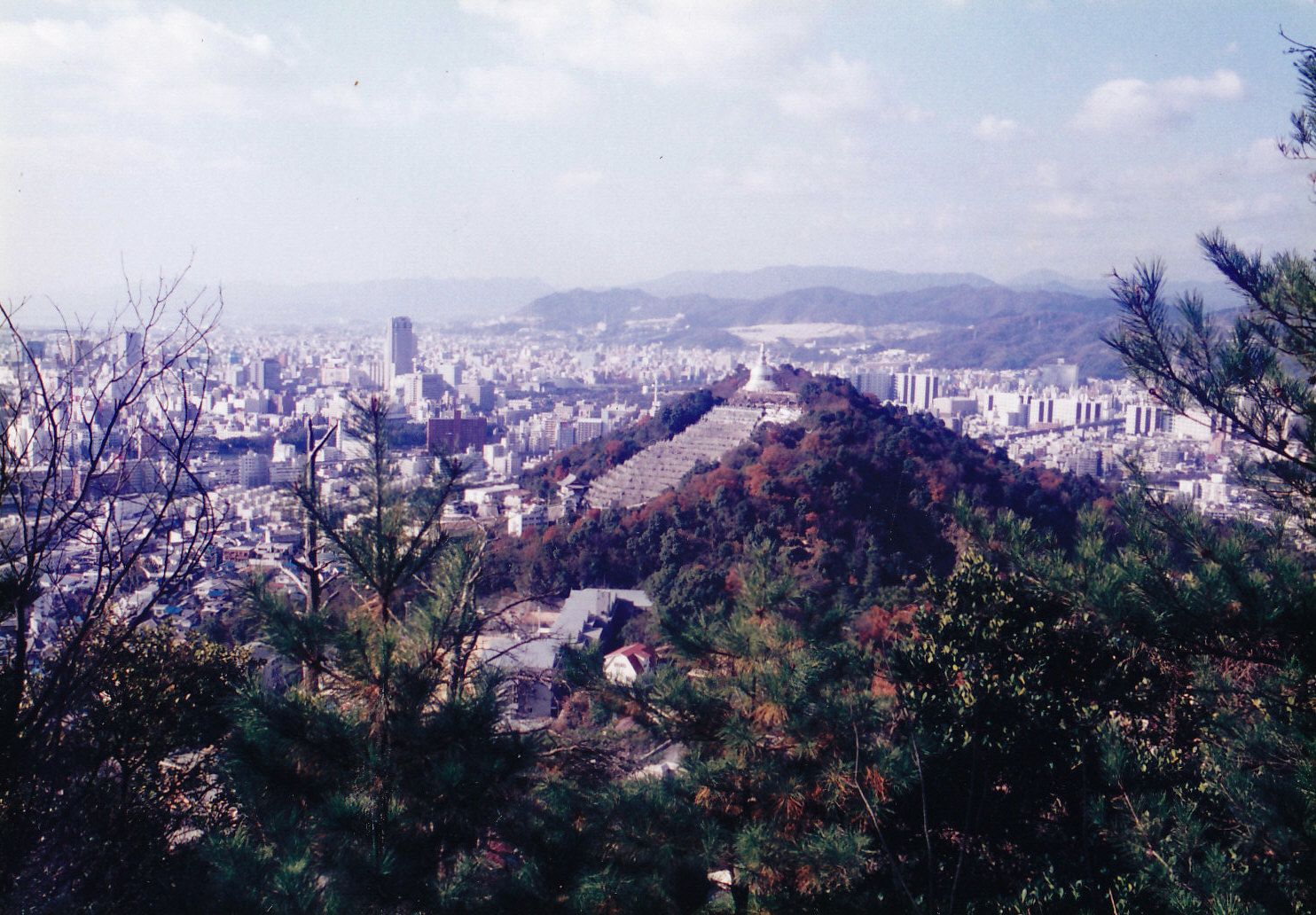| Top Page | Mountains, Valleys & Waterfalls |
|
Mt. Ushita (261m) |
|

|

|
|
Ushita Higashi Ward, Hiroshima City | |
|
牛田山 牛田 | |
| Map | A view of the silvery 25-meter-tall pagoda, in which Buddha's ashes from India are laid, from Mt. Onaga. |
|
Mt. Ushita (牛田山) is only 4 kilometers north from Hiroshima Station, and situated in Ushita, Higashi Ward,
which is the uppermost part of the Hiroshima delta formed by the Ota River. It is said that the Ushita area was reclaimed
in the end of the Nara period (710~784) as a manor of Saidaiji Temple in Nara, an ancient capital of Japan.
Take a counterclockwise 7-kilometer hiking course, enjoying superb views of the city, overlooking Hiroshima Bay, from the north side of JR Hiroshima Station. First cross the street (Futaba Dori) at Hotel Granvia and head north to Hiroshima Toshogu Shrine (広島東照宮), which is situated at the foot of the 139-meter Mt. Futaba (二葉山) where the shining silvery Peace Pagoda stands. The shrine was originally built in 1648 by Mitsuakira Asano, head of Hiroshima Castle, and dedicated to Ieyasu Tokugawa, Shogun of the Edo Bakufu government. From there, walk up to the Peace Pagoda on Mt. Futaba. It was built by local residents in 1966 to console the spirits of the A-bomb victims. Then walk down for five minutes on the paved road and turn left to a narrow trail and walk down for another five minutes to Ushita-Higashi 3-chome. There is an Italian restaurant on the right, and go up straight to a white five-story apartment building. An entry point of the next 176-meter Mt. Onaga (尾長山) is at the back of the building. After climbing up on a steep slope and reaching Mt. Onaga, signboards lead you to the 261-meter Mt. Ushita, the 178-meter Mt. Kanda (神田山) and the 116-meter Mt. Mitate (見立山). An explanation board at Mt. Mitate, which is located in the back of Higashi Ward Sport Center, says as follows: Terumoto Mori, a feudal lord, who was based in Koriyama Castle (45 km northeast of Hiroshima) and governed almost the entire Chugoku region, came to Hiroshima in 1589 to seek a better location for his new castle. After he went up a couple peaks to have a good view of the Hiroshima delta, he went up this peak and saw what looked like an island, on which many reeds grew thick, and decided to build the castle there. The construction of it began that year. It was done at a fast pace even though the ground was very soft. He was able to enter his new castle in 1591. Then go down to the Ushita-Asahi area and walk to Ushita-Asahi 1-chome, a supermarket, Fresta, is on the corner. Turn left at Fresta and walk for 30 minutes back to Hiroshima Station. Or turn right and walk for 15 minutes toward Route 54 (Gion Shindo), passing Higashi Ward Sports Center, to Higashiku- Sports Center-Iriguchi bus stop. You can take a bus bound for JR Hiroshima Station via Hiroshima Bus Center. There is a relaxation facility named Kanda-sanso (神田山荘), halfway down Mt. Kanda to Ushita-shinmachi. It is a good place to drop by for a hot bath to make you feel refreshed after a good hike. Another suggested destination is Fudoin Temple (不動院) in Ushita-Shinmachi which stands on the east bank of the Ota River. The temple was built in the middle of the 14th century by Shogun Takauji Ashikaga as one of 60 Ankokuji temples which were constructed in all provinces in the nation, praying for the repose of people killed in battles. The Kondo (main hall) of the temple, which is said to be one of the largest remaining structures in the medieval Kara style in the country, is the only designated national treasure in Hiroshima City. The Kara style originally came from the south of China. Getting there: From the north side of Hiroshima Station, head for north to Hiroshima Toshogu Shrine. Suggested schedule: North Side of JR Hiroshima Sta.(9:00)---Hiroshima Toshogu Shrine(9:15-9:30)--- ---Mt. Futaba(10:00-10:15)---Mt. Onaga---Mt. Ushita(11:30-12:30)---- ---Mt. Kanda(13:00)---Mt. Mitate---Ushita-Asahi 1-chome(13:30)--- ---JR Hiroshima Sta. (14:00) Note: To be safe, especially in winter, keep in mind not to go into the mountains alone, and be sure to go with a well-experienced hiker. |
|